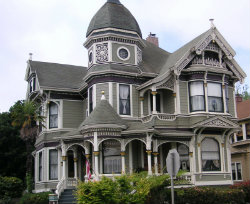Summary | Excerpt | Reviews | Beyond the Book | Read-Alikes | Genres & Themes | Author Bio

A Novel
by Laura McHughThis article relates to Arrowood
Laura McHugh's atmospheric novel Arrowood is set in Keokuk, in the south-east of Iowa, where the Des Moines River meets the Mississippi. This setting is an important component in establishing the sense of the past overshadowing the present — a major theme in the story. The house, Arrowood, plays a vital role and McHugh's descriptions of real and imagined historic homes in Keokuk, refer to the following styles of architecture:
Second Empire
 Arrowood is described as being built in the Second Empire style that became popular in the 1870s after the Civil War. Second Empire homes are characterized by steep, sloping Mansard roofs, named after the seventeenth-century French architect François Mansard. Arrowood is certainly a house of substance, even featuring a "porte-cochere," a porch that provided a covered area for arriving horse and carriages.
Arrowood is described as being built in the Second Empire style that became popular in the 1870s after the Civil War. Second Empire homes are characterized by steep, sloping Mansard roofs, named after the seventeenth-century French architect François Mansard. Arrowood is certainly a house of substance, even featuring a "porte-cochere," a porch that provided a covered area for arriving horse and carriages.
Italianate
This style of house, popularized in the United States in the mid-nineteenth century by architects such as Andrew Jackson Downing, takes its name from the square Italian villas that inspired it. Italianate homes are tall – at least two and possibly three or four stories high – and characterized by low pitched roofs with projecting eaves sporting decorative features such as brackets and cornices.
Gothic Revival
Also popular in the early to mid-nineteenth century, were homes built in a Gothic revival style, characterized by steep pointed roofs and arched windows. Gothic homes often have an ecclesiastic flavor complemented by unique designs that feature asymmetrical rooms and floor plans. As the century progressed, what is called Carpenter Gothic developed: buildings in the gothic style built with wood rather than brick or stone. In the United States, one of the most recognizable homes in this style is The American Gothic House in Eldon, Iowa made famous in Grant Wood's 1930 painting, American Gothic.
Romanesque Victorian
In the 1870s, the Romanesque style became popular, particularly for large impressive homes reflecting the success of American industrialization. Romanesque homes are characterized by their grand scale, their use of red brick or stone, low roofs, large arched entrances and wide arched windows.
Queen Anne
 Although the Queen Anne for whom this style of architecture is named, reigned in Britain from 1702 to 1714, Queen Anne homes in America were fashionable in the late decades of the nineteenth century. They feature wrap-around porches, towers, turrets and multiple gable and dormer windows. This style was highly popular and embraced by the growing middle class benefitting from the industrial boom.
Although the Queen Anne for whom this style of architecture is named, reigned in Britain from 1702 to 1714, Queen Anne homes in America were fashionable in the late decades of the nineteenth century. They feature wrap-around porches, towers, turrets and multiple gable and dormer windows. This style was highly popular and embraced by the growing middle class benefitting from the industrial boom.
Jacobean
Jacobean style architecture harks back to the Stuart era - during the reign of James I of England (VI of Scotland). More classical in style than gothic architecture, Jacobean homes built in America in the late nineteenth and early twentieth centuries, are characterized by steep roofs and decorative terracotta brick work, often with a lighter brick or stone trim around windows and doorways.
Neoclassical
A revival of neoclassical style in architecture occurred in the last years of the nineteenth century and gained great popularity in the early decades of the twentieth. This is a style recognizable for its symmetry, its full height porches and columns, reminiscent of Greek temples.
Picture of Heck-Andrews House in Raleigh, North Carolina (Second Empire style) by Mark Turner
Picture of Queen Anne style home from Activerain.com
Filed under Cultural Curiosities
![]() This "beyond the book article" relates to Arrowood. It originally ran in August 2016 and has been updated for the
May 2017 paperback edition.
Go to magazine.
This "beyond the book article" relates to Arrowood. It originally ran in August 2016 and has been updated for the
May 2017 paperback edition.
Go to magazine.
Your guide toexceptional books
BookBrowse seeks out and recommends the best in contemporary fiction and nonfiction—books that not only engage and entertain but also deepen our understanding of ourselves and the world around us.